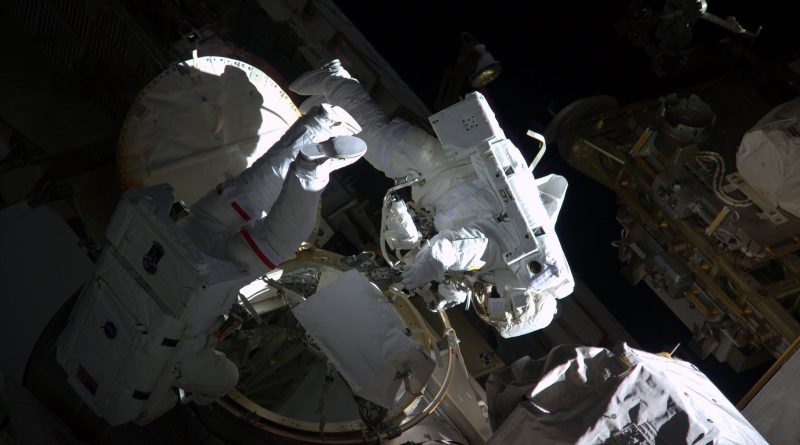ISS Spacewalker Duo to Install External Avionics Package & HD Camera
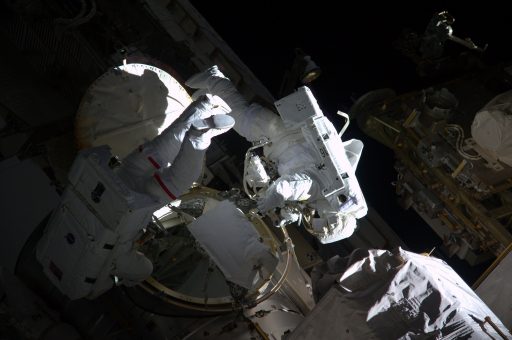
Two astronauts aboard the International Space Station are gearing up for the 200th spacewalk in support of ISS Assembly and Maintenance set for Friday to install a new payload controller on the Station’s truss, diagnose degrading thermal control on the Station’s flagship astrophysics instrument, put in place an external HD camera and install a series of wireless communication antennas.
The Space Station’s first 199 spacewalks amassed a cumulative EVA time of 1,245 hours and spacewalkers Peggy Whitson and Jack Fischer plan to add another six and a half hours on Friday as part of U.S. EVA-42. Their primary task will be the installation of a payload controller on an external logistics carrier to prepare for the arrival of a new Earth-science instrument bench on the upcoming SpaceX Dragon mission, but the EVA also includes a series of smaller tasks to continue enhancing the Station’s external systems.
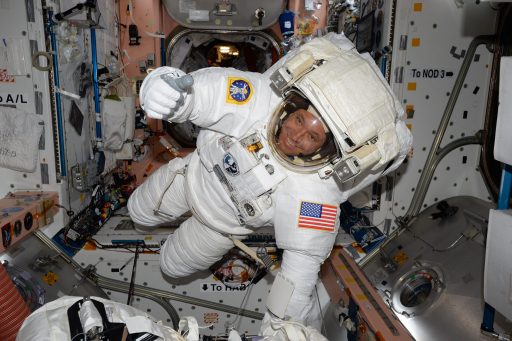
ISS spacewalks began in December 1998 when Jerry Ross and James Newman ventured out on three EVAs as part of the STS-88 mission that delivered the first U.S. building block of ISS to orbit – the Unity Module with two Pressurized Mating Adapters on either end. Their EVAs were dedicated to building the electrical/data bridge between the U.S. and Russian sides of the station.
Over the years, ISS EVAs became more complex, accomplishing major assembly steps such as the integration of the 109-meter long truss segment and dealing with urgent maintenance tasks like the replacement of failed components outside the safety of the pressurized modules. To date, the majority of ISS spacewalks were carried out by visiting Space Shuttle crews as the fast-paced nature of STS missions allowed crews to work a more challenging schedule for a few days, including back-to-back EVAs.
Since the Shuttle’s retirement, spacewalking operations transitioned to a more general training approach for ISS crews including rehearsals of EVAs dealing with major equipment failures. But different from the days of Shuttle, crews no longer train entire choreographed EVAs and often complete procedures without specific ground training at all. Friday’s EVA is slightly different from that as both spacewalkers were able to rehearse the central task of the EVA in the Neutral Buoyancy Laboratory prior to departing for ISS.
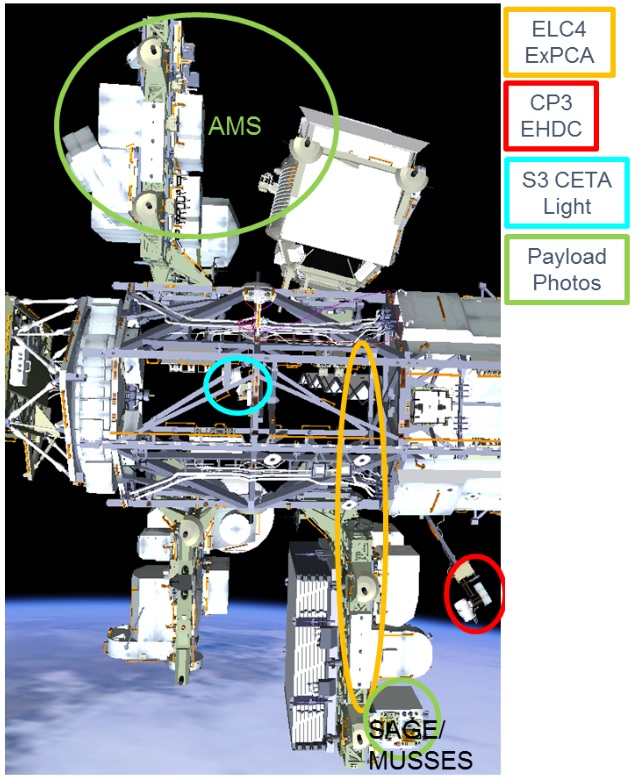
Friday’s spacewalk was originally planned to occur as part of a series of EVAs in late March and early April, but the delay of the Cygnus OA-7 cargo mission forced EVA-42 to be pushed from Expedition 50 to Expedition 51 because two critical parts for the spacewalk were launching on Cygnus, specifically the Express Carrier Avionics and the AMS-2 1553 Feedback Terminator.
Per the original plan, EVA-42 was to be performed by Peggy Whitson and ESA Astronaut Thomas Pesquet, however, with the slip into Expedition 51 it was decided to substitute Pesquet with NASA Astronaut Jack Fischer who arrived at ISS aboard Soyuz MS-04.
It is NASA’s desire to give as many astronauts as possible a hands-on EVA experience in orbit and Pesquet has already participated in a pair of EVAs earlier this year. Another factor in the decision was Fischer has more recent ground-based training experience for this specific EVA.
It will be the first excursion for Fischer, joined by EVA veteran Peggy Whitson who conducted her first ISS EVA back in 2002 and since accumulated eight career EVAs for a total of 53.5 hours. If Friday’s EVA runs the scheduled duration of 6.5 hours, Whitson will move up to third on the all-time list for career EVA time.
Preparations for EVA-42 began in late April with reconfigurations of Extravehicular Mobility Units #3006 and #3008 and preparations of tools. Whitson & Fischer – along with Pesquet who will handle robotic operations – went through a series of procedure reviews over the past several days and, on Tuesday, the spacewalkers conducted pressurized fit checks in their suits, also giving Fischer a chance to exercise his translation inside ISS before venturing outside.

Friday will begin bright and early for the crew, ingressing their space suits for checkouts and two hours of pre-breathing and light exercise to remove nitrogen from their blood. They will then move into the Quest crew lock for a methodical depressurization ahead of opening the external hatch and the transition of their suits to battery power – marking the formal start of the EVA, currently planned for 12:00 UTC.
Egressing the Quest airlock, the crew will set up shop with the typical checks of their suits and tethers, and also move equipment needed for the EVA outside – wireless antenna assemblies will be temp-stowed at the airlock while Whitson will take control of the large ELC avionics box and Fischer carries a large ORU bag.
Peggy Whitson will make her way starboard to Express Logistics Carrier 4 (ELC-4) that is installed on the nadir-face of the S3 truss and will be the first worksite for Friday’s EVA.
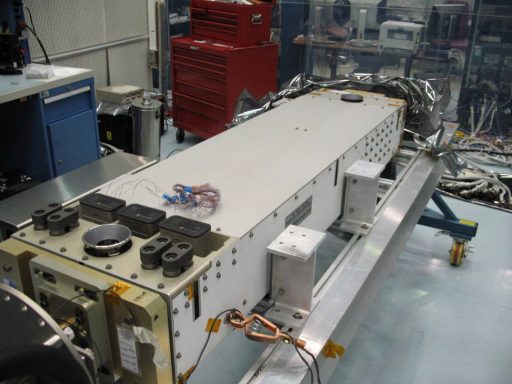
The Space Station has four Express Logistics Carriers, delivered in 2009 and 2011 by three Shuttle missions and loaded with various spare parts, known as Orbital Replacement Units that were pre-positioned on ISS for use in the second half of the Station’s life after the Shuttle’s retirement.
Each 4.3 by 4.9 meters in size, the ELCs also provide accommodations for external payloads like Earth Science instruments and technology demonstration payloads. The main focus of Friday’s EVA will be on the ELC-4 ExPRESS carrier avionics (ExPCA) – a central component of the ELC that delivers electrical power and data connectivity to the experiments and spares installed on the ELC.
The ExPCA on ELC-4 is considered partially failed and needs to be replaced prior to the arrival of the Multi-User Earth System on the next Dragon mission that will host up to four Earth-pointed instruments in the future and requires a high-speed data link with ISS. The ExPCA hosts MIL-1553 command interfaces to control the various ELC payloads, hosts a fiber optical data bus to transmit high-rate science data to ISS, provides a LAN interface with the various experiments, and facilitates analog input and command channels.
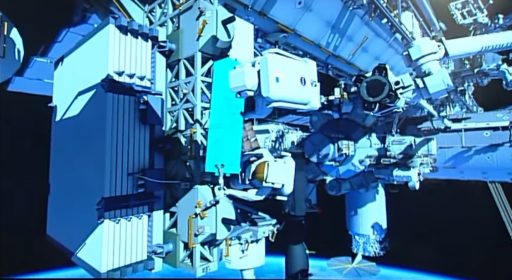
The ExPCA is a relatively balky piece of hardware, residing on the forward-facing side of the ELC, in between a pair of scuff plates. A large number of blind-mate connectors forming the electrical / data interface reside on the back of the ExPCA, making its removal and replacement fairly straightforward without the need for extensive cabling work.
Setting up shop at the ELC-4 worksite, Whitson will prepare the ExPCA by installing a pair of scoops and breaking torque on a pair of structural bolts holding unit in place. She will also set up a Multi-Use Ball-Stack Tether (MUT) on the ELC-4 to act as temp-stow location for the ExPCA once removed. In the meantime, Fischer will prepare the robotic arm by installing a foot restraint and ingress the restraint to allow Thomas Pesquet to move him over to ELC-4 to assist with the ExPCA replacement using both of his hands.
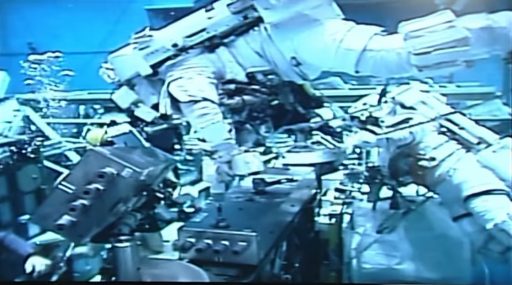
When the old ExPCA is removed, it will be secured in its temp-stow location and the two spacewalkers will move zenith to S3 where Whitson will have secured the spare earlier in the EVA.
Whitson will release the spare and Fischer will take control of it via a pair of scoops or handles and guide Pesquet to move the arm back into a position on ELC-4 for installation of the ExPCA. Peggy Whitson will position herself to guide Fischer into position via a pair of pins on the receptacle on ELC-4. When the ExPCA is in position, Fischer will use the Pistol Grip Tool to secure the structural bolts to mark the completion of EVA’s first and most critical task.
The old ExPCA will be removed from the MUT and placed on S3 so that Whitson can retrieve it on her trip inboard to the airlock later in the EVA.
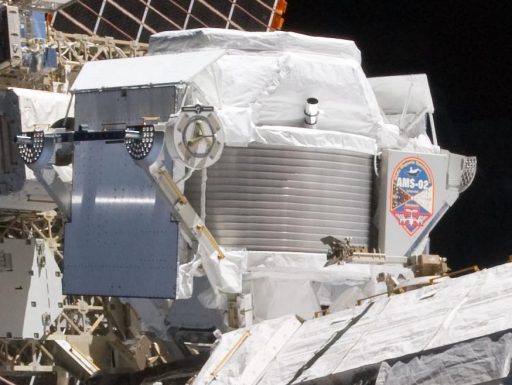
Afterwards, the two crew members will part ways – Whitson will be headed zenith to AMS-2 while Fischer remains on the arm for the HD Camera installation task. At this point, a task may be inserted for either crew member to photograph the 3B solar array wing where a tear was recently found in one of the array hinges, spanning around 15 centimeters in length. Assessments by Mission Control have been ongoing since early May and additional footage is desired to assess whether the tear could become a concern in the future.
Heading up and around the S3 truss segment, Whitson will reach the Alpha Magnetic Spectrometer 2, the Space Station’s prime astrophysics payload tasked with exploring the high-energy universe. At one of the AMS connector panels, Whitson will install a 1553 Feedback Terminator Cap which will essentially act as a line tester – allowing Mission Control to assess whether this particular 1553 line is still functional and would be available for providing commands/data to a future addition to AMS-2.
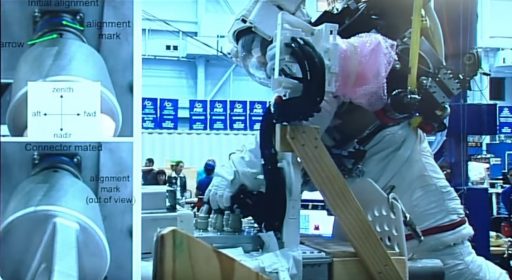
Over recent years, AMS-2 has shown some degradation in its thermal control system and since there is a strong desire to keep the instrument operational for as long as possible, reviews have gotten underway on adding thermal control equipment. Detailed photo surveys were performed on recent EVAs to provide guidance for additional blankets that could be added to AMS-2 and the 1553 cap will allow assessments into adding active thermal control equipment to the payload.
While in the area, Whitson will capture close-up engineering photos of AMS-4 before climbing down to ELC-4 again to conduct a photo survey of the SAGE-III payload that was delivered earlier this year by the Dragon SpX-10 spacecraft and has taken residence on ISS for a multi-year mission monitoring ozone and aerosols in Earth’s atmosphere.
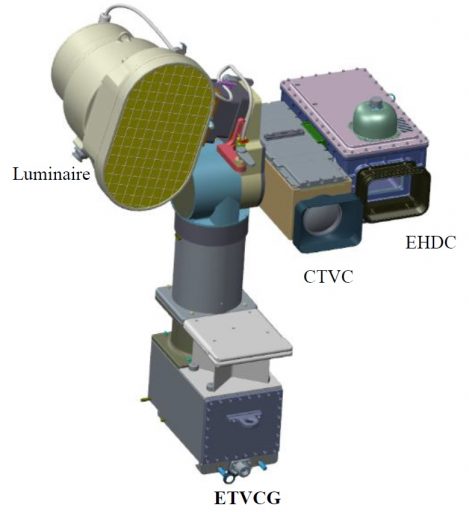
Still riding the arm, Fischer will be moved over to Camera Port 3 on S3 where he will be tasked with the installation of an External High Definition Camera Assembly to continue the Station’s transition to the 21st century by giving ISS high-definition vision for external video and still imagery. The first two external HD cameras were installed on U.S. EVA-37 last year and their views have not disappointed and have also come in handy for engineering assessments of external systems.
The CTVC cameras currently in use on the outside are standard-definition cameras with a 4:3 aspect ratio which had been the state of technology when the Station was designed in the 1990s.
The External High Definition Camera Assemblies (EHDCAs) have been specifically designed as an add-on, not requiring the existing camera network to be touched to maintain its full functionality. Each EHDCA houses a commercial Nikon D4 DSLR in a pressurized, thermally controlled housing. An electrical motor is responsible for setting the zoom level on a 28-300 lens which will allow for close-up inspections of external components.
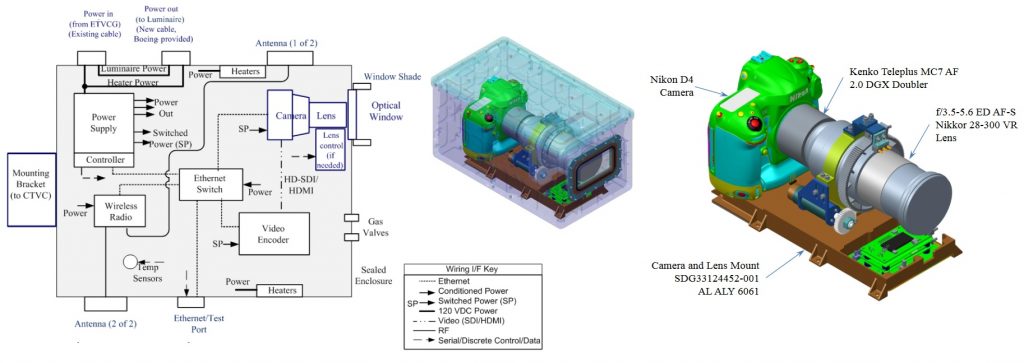
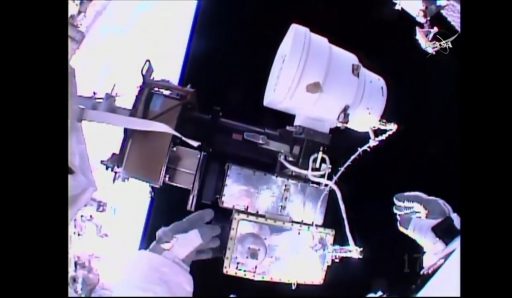
The cameras can be operated to deliver 720p, 60fps video or 16.2-megapixel still images (ISO 100-12800), making them an extremely useful tool for external inspections carried out remotely from the ground as well as Earth imaging without the need for crew time. Each 12.8-Kilogram EHDCA comprises a pressurized enclosure, holding the commercial off the shelf camera, the lens assembly, a power supply, heaters and a data system consisting of an h.264 video encoder, an Ethernet switch and a pair of wireless radio antennas.
To avoid excessive external reconfigurations, the camera units were designed to only tap into the Station’s 120 VDC power supply and send imagery wirelessly to the inside of the Station where footage is stored ahead of downlink to the ground. Therefore, installing the cameras is relatively simple, requiring Fischer to slide the new camera into place, secure its mechanical connection and plug into the CP electrical circuit. In the new arrangement, the SD and HD video cameras share a Camera, Light Pan and Tilt Assembly and always point to the same direction.
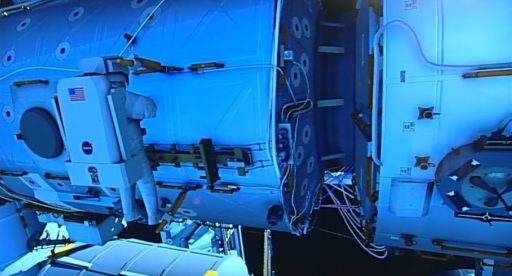
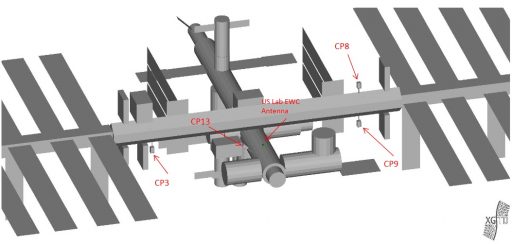
Next for Fischer will be the deconfiguration of the arm before the two spacewalkers pass by the airlock to switch out tool bags and head forward on the Destiny lab to reach the recently-relocated Pressurized Mating Adapter-3 where they will finish the installation of covers started by the two recent EVAs in March/April.
Fischer will then translate around the lab for the installation of a pair of External Wireless Communications (EWC) antennas. Prerequisite for the EWC task was the removal of handrails completed earlier by Shane Kimbrough, allowing Fischer to simply install the new antennas at their respective Worksite Interfaces and connecting them to the ISS communications infrastructure via a single cable.
Expanding the EWC coverage is necessary for the external HD camera assemblies; the Lab EWC antennas will become the primary receiving point for the four planned HD assemblies at camera ports 8,9, 3 and 13, routing 10Mbps video into the Station’s hard-line comm system for live downlink to the ground via Ku-Band.
This will conclude the planned task list for EVA-42, however, there are plenty of open items on the get-ahead task list available for this and future EVAs.
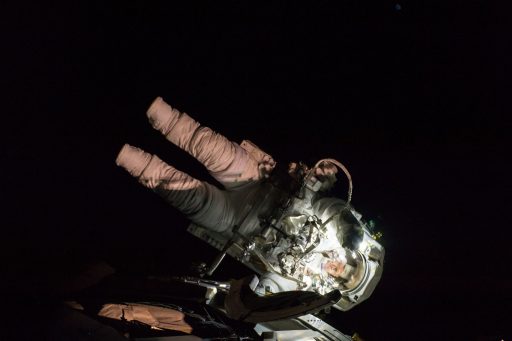
One item that is of particular interest is the replacement of a camera lens cover on the robotic arm as that camera has shown a much degraded view that teams suspect is caused by some contamination on the camera lens cover. To give robotic controllers are clear view of their work, the spacewalkers will be tasked with removing and replacing the CLPA cover, a relatively quick task.
Two tasks on External Stowage Platform-2 are to ready a Flex Hose Rotary Coupler and Ammonia Pump Module Combined Cargo Element for potential future installation by configuring covers so that the Station’s robots could remove them from the stowage platform. Another quick task is the installation of a T-Handle on a Radiator Grapple Bar.
The final task list item and one of the longer get-ahead tasks is the preparation of a dozen batteries on the Station’s S6 truss segment that are next to be replaced with higher-capacity Li-Ion batteries.

